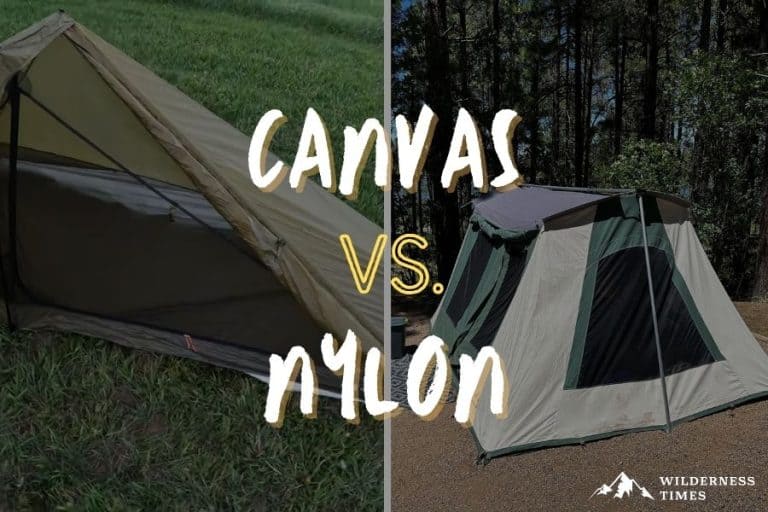In the market for a new camping tent, but not sure whether to look for canvas vs. nylon tents?
You’ve come to the right place!
This article will tell you all about what each tent fabric has to offer.
Canvas Vs. Nylon
FEATURES | CANVAS | NYLON |
Comfort | ||
Durability | ||
Weather Resistance | ||
Cold Weather Use | ||
Sustainability | ||
Maintinance | ||
Portability | ||
Price |
Comfort
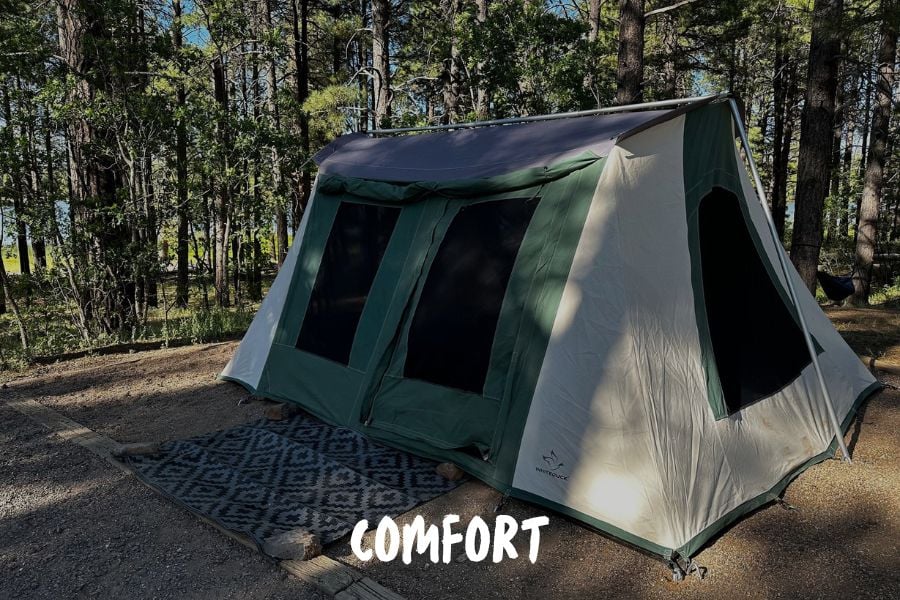
Because canvas is a natural material, it’s more breathable than nylon, which is a synthetic material. This means that the airflow in canvas tents is better than in nylon tents.
This means you’re less likely to get condensation inside your tent, which can sometimes be a problem when you have a synthetic tent made of a material such as nylon.
Although it’s more breathable, canvas is also a better insulator. This means you’ll be able to stay cool when it’s hot out, and warm when it’s cold out.
For these reasons, it’s safe to say that the level of comfort provided by a cotton canvas tent exceeds that of a nylon tent by quite a bit.
Which material provides more comfort? Canvas.
Durability

So, here’s the deal. Both canvas and nylon are highly durable materials.
That being said, canvas is more resistant to tearing than nylon is. Its thick threads prevent small rips from becoming larger over time.
However, if you get a tent that’s made of Ripstop nylon, it’ll also be highly durable. Like canvas, Ripstop nylon prevents insignificant damage from becoming more significant.
If you do get a rip in your canvas tent, you can easily stitch it back up with a sewing kit.
To repair nylon, on the other hand, you need a special patch, which is somewhat more of a hassle.
Although canvas is more durable, nylon still has a better strength-to-weight ratio. It’s much lighter than canvas, but only slightly less durable.
Which material is more durable? Canvas.
Portability
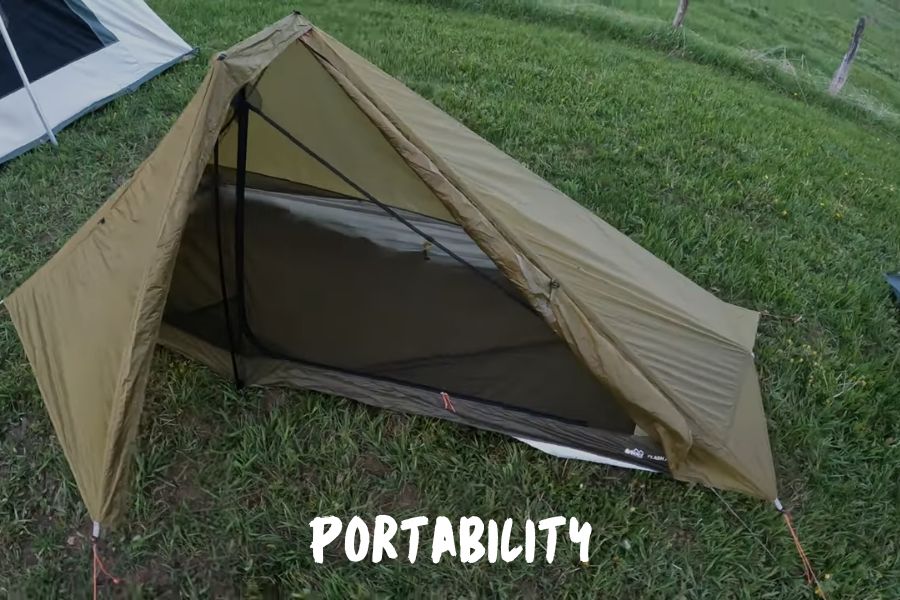
When it comes to portability, nylon has definitely got the upper edge.
Nylon tents are lightweight, making them an excellent choice for backpackers and anybody looking to keep their load light. They’re also more compact, making them easier to carry around.
Canvas tents are significantly heavier and bulkier. If you’re car camping, this won’t be too much of an issue. For backpackers, however, canvas should definitely be avoided at all costs.
Which material is more portable? Nylon.
Weather Resistance
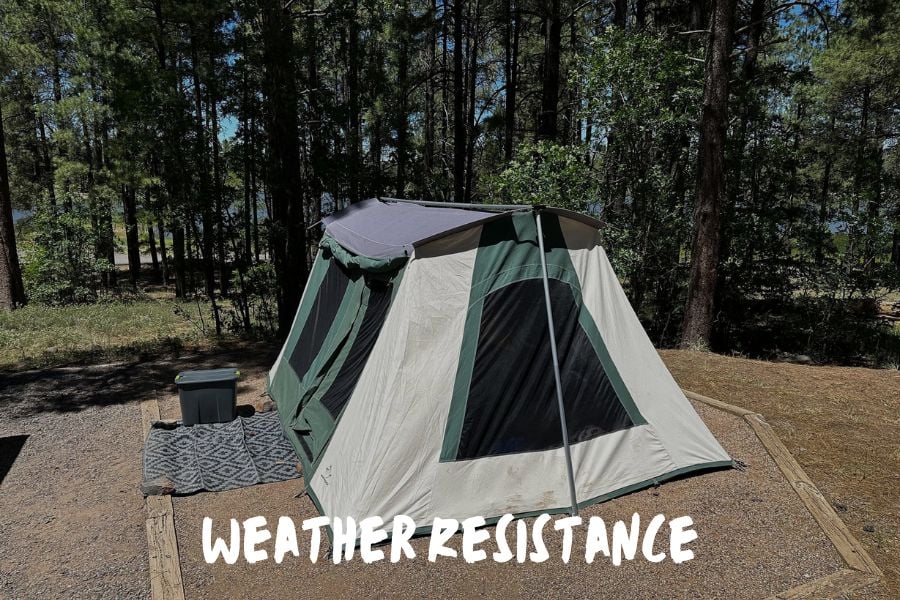
Okay, so what about the elements? Which tent is going to hold up better against strong winds, rainfall, and sunny rays beating down onto it?
Well, when it comes to UV resistance, canvas tents come out on top. Nylon tents will wear down over time because of repeated exposure to the sun. For this reason, a canvas tent will ultimately last you much longer than a nylon tent.
Canvas tents also tend to be more stable in windy conditions than nylon tents.
Neither tent fabric is waterproof in itself. A nylon tent needs a rain fly to protect it from water, whereas a canvas tent needs waterproofing before you use it.
With these measures in place, both tents will have a similar degree of water resistance.
On a final note, nylon tents are quicker to dry than canvas. That means that if your tent gets wet and you don’t have enough time to let it fully dry, you’re less likely to have trouble with it developing an odor if it’s nylon.
Which material is more weather resistant? Canvas.
Cold Weather Use
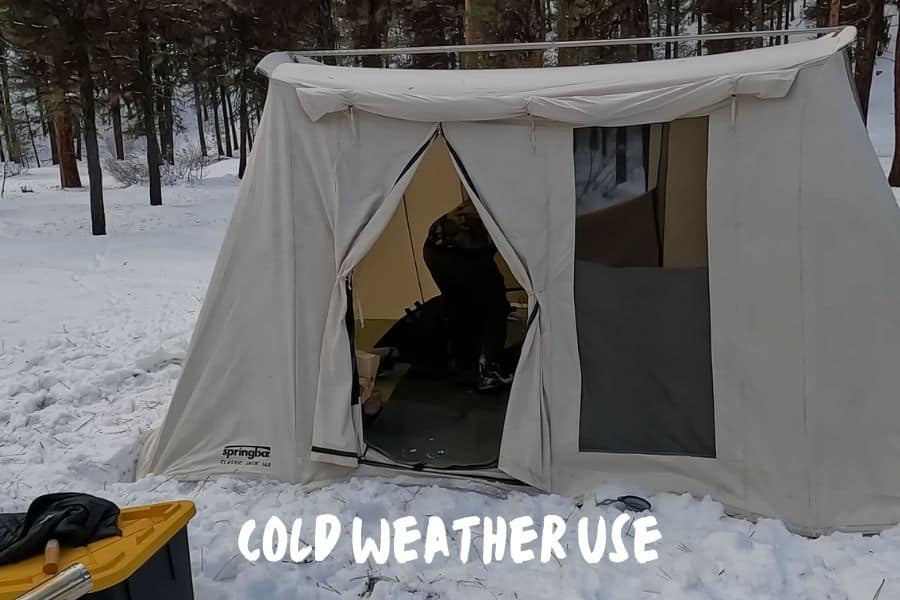
Canvas is made of cotton, which is a fantastic insulator. This means that a canvas tent does a great job at keeping you cool in the summer and warm in the winter.
It’s also better at retaining heat. If you’re using a tent heater to heat the inside of your tent, the space inside will stay warmer for longer in a canvas tent.
That being said, there are still plenty of 4-season and even 5-season tents out there that are made of nylon.
If you’ve got one of these, and the right kind of gear for winter camping, you’ll be just fine in a nylon tent.
Which material is better for use in cold weather conditions? Canvas.
Maintenance

Now, different tent materials all require some kind of weatherproofing.
This can be done by applying a waterproofing spray. With canvas tents, however, it can also be done by just drenching the tent completely, and letting it dry out.
This can be done once, or may need to be done several times, depending on the particular tent.
Now, as I mentioned, canvas tents take longer to dry out. This makes them more susceptible to mildew. Because of this, you’ll need to clean a canvas tent more often than you would a nylon tent, to make sure you don’t end up with a moldy tent.
When you’re cleaning a canvas tent, make sure to do so carefully. You don’t want to use a pressure cleaner or hose, and you don’t want to scrub the canvas tent fabric. Also, make sure you’re using water that isn’t any warmer than rainwater would be.
Nylon tents aren’t as sensitive, and you don’t have to take so many precautions when cleaning them. You can even get away with washing them in the washing machine most of the time.
For this reason, I’d say a nylon tent is definitely easier to maintain than a canvas tent.
Which material is easier to maintain? Nylon.
Environmental Sustainability
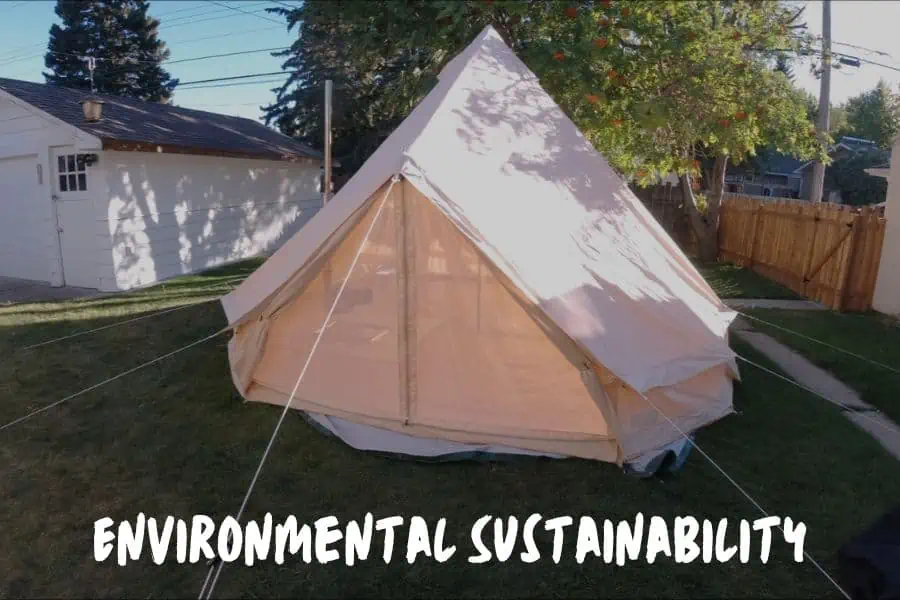
Another aspect that shouldn’t be ignored is environmental sustainability. This is another category where canvas shines.
Because it’s a natural material, canvas is biodegradable. This means that once it’s reached the end of its lifespan, it’s able to degrade back into the earth, without leaving any trace or harming the planet in any way.
Nylon fabric, on the other hand, is a man-made fabric made from petroleum. Petroleum is a non-renewable resource, and making these tents involves the use of harmful chemicals.
This process also produces toxic waste as a byproduct, which is harmful to the environment, as well as animals and humans.
That’s not all, though.
Once a nylon tent’s lifespan has come to an end (which will be quicker than a canvas tent, by the way) it will end up sitting in a landfill.
As time passes, it’ll break down into microplastics, which end up in the air we breathe and the water we drink.
That means that a nylon tent will continue to wreak havoc on the environment, long after you’ve stopped using it.
Which material is more environmentally sustainable? Canvas.
Price

Canvas tents are generally more expensive than nylon.
This is because canvas is made of cotton, a natural material. Nylon, on the other hand, is synthetic and is therefore more affordable.
4-season tents that are made to withstand extreme temperature conditions are the main exception. These are often made of nylon, but can be more expensive than a canvas tent.
Which material is cheaper? Nylon.
Things To Consider When Buying Canvas Vs. Nylon Tents
Purpose & Camping Type

One of the main differences between canvas and nylon tents is their weight. In general, canvas tents are going to be the heavier option when compared to their nylon counterparts.
Because of this, canvas tents are going to be the best option for car camping, or scenarios where you don’t need to carry your tent over long distances. This is especially true when you consider canvas’ tendency to be bulky.
In comparison, nylon tents are known for being lightweight and portable, or easily condensed in your pack.
These qualities make them the best option for backpacking, or scenarios in which you will be carrying your shelter for long periods of time.
Weather & Environmental Conditions

Both types of tents can help keep you warm and protected throughout various weather conditions.
However, in some cases you should prioritize one fabric over the other depending on expected weather or environmental conditions.
Desert
Canvas tents are made from cotton, which makes them infinitely more breathable than nylon tents.
Because of this, canvas tents are usually the better option for desert camping because they do not store heat like their nylon counterparts.
Nylon tents do not have strong breathability qualities outside of their mesh ventilation systems.
This can create a build up of heat and moisture in the tent during the temperature changes that desert nights are known for.
Rain & Storms
There isn’t a clear winner between the two types of tents for rainy weather conditions.
Nylon tents are generally more waterproof but can lack ventilation.
This can lead to condensation build up during a rainstorm. In comparison, canvas tents are consistently water-resistant, but not waterproof.
These tents will need to be treated more frequently with waterproof coatings to keep rain fully out of the tent.
These tents also get substantially heavier when wet, which can make portability difficult.
However, canvas tents are more breathable, meaning that you will not experience the same issues with condensation as you would with a nylon tent – even during a bad storm.
Snow & Cold Conditions
While there are some 4-season nylon tents that will stand up to an extreme cold environment, canvas tents are the better option for cold weather camping.
Their fabric allows moisture to leave the tent interior while maintaining the body heat created inside.
This combination will keep you feeling warm and toasty, no matter how cold it gets outside your tent.
In extreme cold weather camping, you can even bring a “hot tent” made from canvas, which incorporates space for an internal heater within the design.
Budget Constraints

In general, nylon tents are going to be the more affordable option between the two types of tent.
If you are looking for a multipurpose tent at an affordable rate, nylon materials should be your first option.
Canvas tents are made from cotton while nylon tents are made from synthetic materials.
As a rule, the cotton required in their production is more expensive to buy, produce, and treat with waterproof coatings.
In comparison, nylon materials are easier to create and produce into tents, leaving way for a lighter price tag.
The exception to this rule lies with 4-season tents which, although made from nylon materials, contain additional design and material layers to ensure they can keep their occupants warm – even in the harshest conditions.
Depending on the size of the 4-season tent, they can be even more expensive than a canvas tent.
Long-Term Vs. Short-Term Usage

If both tent types are taken care of properly and fully dried out before being placed in storage, it is likely that the canvas tent will last longer and be able to be used for a longer period of time.
The main reason for this is that nylon materials are more susceptible to sun damage, so every time you use them in the open they are getting damaged.
Canvas tents hold up much better to sunlight and won’t have a similar issue at the same rate.
Both types of materials can be patched up and repaired if torn or ripped.
FAQs
Which Tent Material Is More Suitable For Rainy Environments?
It depends. If you’re looking for a warm retreat from the rain and don’t have to worry about carrying the weight of the wet tent on your back, canvas may be for you.
If you need a tent that will protect you from the rain, then pack up for your trek the next day, a nylon tent will be your best bet.
How Do Canvas & Nylon Tents Perform In Snowy Conditions?
In general, canvas tents generally perform better in snowy conditions when compared to nylon tents.
This is largely due to their fabric’s ability to wick away moisture and retain heat.
However, there are also 4-season nylon tents that are designed specifically to retain heat in snowy conditions.
Are There Significant Cost Differences Between Canvas & Nylon Tents?
It depends. Canvas tents are usually more expensive than nylon tents, but price can vary between sizes and models.
Which Tent Material Offers A Better Lifespan?
Canvas tents will last longer than nylon tents over a long period of time due to the material’s durability and sun resistance.
How Do I Maintain & Care For Each Type Of Tent Material To Maximize Its Life?
Just like most tents, you will need to periodically clean and repair both canvas and nylon tents to maintain them over a long period of time.
Both types of tents should also be fully dried out before long term storage to prevent mold and mildew growth.
Because canvas is a heavier material than nylon, it can take a longer time to dry out.
Be sure to leave canvas out to try for a longer period of time, and ensure that it is completely dry, before storing it away.
Are There Any Hybrid Tents That Combine Both Materials?
While most canvas tents contain some level of nylon or synthetic materials, it is rare to find a tent that has a 50/50 makeup of canvas and nylon.
The Final Verdict
FEATURES | CANVAS | NYLON |
Comfort | ||
Durability | ||
Weather Resistance | ||
Cold Weather Use | ||
Sustainability | ||
Maintinance | ||
Portability | ||
Price |
As you can see, each tent fabric has its own set of pros and cons.
Canvas fabric is more durable and weather-resistant. It also provides better comfort, and performs better in extremely cold weather conditions.
On the other hand, nylon is more portable, easier to maintain, and more affordable.
All in all, if you’re looking for a backpacking tent the choice is clear – a good quality nylon tent that won’t weigh you down on your travels is the way to go.
If you’re a car camper and you don’t mind the extra weight, I’d recommend investing in a good canvas tent. As long as you take proper care of it, it’ll last you for many years to come.


